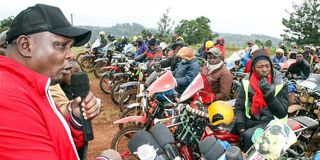Accurate disability data necessary for nation’s inclusive development

Ahadi Kenya Trust CEO Stanley Kamau flags off 3,500 boda boda riders in Gitugi Ward, Murang’a County, on August 7 last year to ferry for free the elderly and persons with disabilities to vote in the August 9 general election.
Kenya’s population census goes way back to its first count in 1948 by the East Africa Statistical Department. Then, the national population was almost that of its capital city today—5.4 million.
Until the recent eighth census in 2019, this data has been useful in informing government, private sector and civil society programmes and policies tailored to changing demographics and growing demand for resources.
But over these years, the generation of accurate data on persons with disabilities (PWD) for planning is a problem, as is the case with many other developing nations.
The number of PWDs in Kenya has been a conflicting statistic with various sources providing different impressions. The 2019 Census puts the number at 918,270 (age five and above), or two per cent of the population—a figure PWDs and their organisations strongly dispute.
Despite Kenya being a youthful nation—which would have a lower disability rate than ageing populations—disability is on the rise due to factors such as road traffic crashes and lifestyle diseases.
WHO places disability at 15 per cent of the general population. In addition, the 2019 disability prevalence rate was also lower than in 2009, at 3.5 per cent, pointing to a decline. But to directly compare 2009 and 2019 data is akin to comparing bananas and oranges; different designs were used in the censuses.
The 2022 Analytical Report on Disability for the 2019 Kenya Population and Housing Census by the Kenya National Bureau of Statistics shows that while the 2009 Census counted as PWDs all those who answered “Yes” to whether they had a disability, the 2019 one enumerated as PWDs those who had ‘A lot of Difficulty’ or ‘Cannot Do at All’ under the Washington Group Short Set of Questions. The other two answers are ‘Some Difficulty’ and ‘No Difficulty’.
Unlike the dichotomous Yes/No static answers, these places focus on the level of functioning (seeing, hearing, walking, remembering, self-care and communication), or the extent to which one can fully participate in day-to-day activities.
Improvement from 2009
That was an improvement from 2009. But since it isn’t specifically designed to be used on children, the questions can’t be effective on under five. Besides, persons with albinism were enumerated separately. A Development Initiatives analysis suggests other reasons for the decline as erroneous answers due to the language barrier, as well as stigma.
The inability to have data that represents the true statistics of PWDs poses a huge risk to stakeholders designing programmes and approaches that are not inclusive. In a world where numbers matter, little data on a population that is a minority group could be the ultimate assurance that they would remain marginalised for an even longer period.
While in disability advocacy a lot of emphasis is placed on appealing to the emotions and moral conscience of the masses, the use of proper data cannot be understated. Hence, having statistics that blur the real image of the disability population will also blot out our insight into who we intend to serve. This could also muzzle the voice of PWDs.
Amid efforts to generate accurate PWD data in Kenya, the National Council for Persons with Disabilities (NCPWD), a state agency mandated to champion and protect the rights of persons with disabilities, is reviewing its database of registered PWDs to capture the rightful ones. There are more than 523,000 PWDs registered by the council, which is still below the census estimates.
Through a new registration system, NCPWD is cleaning up the data with the goal of capturing accurate socioeconomic data of all PWDs down to the ward level. This is also in line with Kenya’s commitment at the 2018 Global Disability Summit to generate properly disability disaggregated data. With the disability medical assessment process now in the counties, more PWDs can easily register, as in the ongoing exercise, so as to access the privileges and services inscribed in law.
For a long time, there has been cynicism that being registered as a PWD has no benefit beyond becoming a statistic. But in partnership with KNBS, the council plans to establish a statistical unit to generate analyses and information for a better understanding of the socioeconomic state of disability.
There is a need to have the disability agenda at the centre of Kenya’s development plans.
Mr Hassan is the chief executive officer, National Council for Persons with Disabilities (NCPWD). [email protected].





